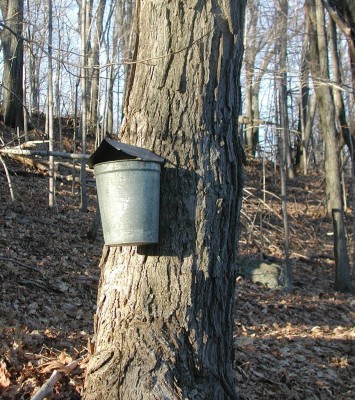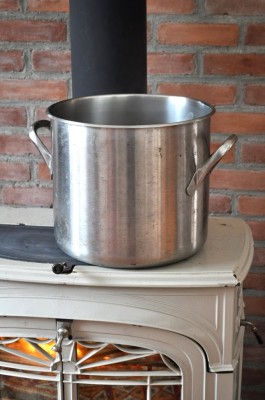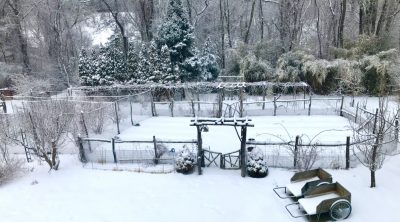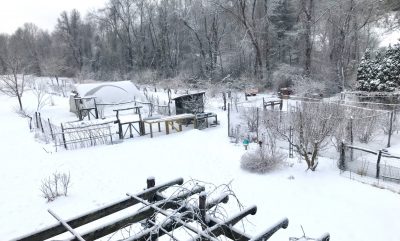Late Winter Sap, Pruning, and Planting
The Sap is Flowing
In past years, now is when we would always hope to make enough maple syrup to last until the following year at about this time. Maple syrup consumption has dropped dramatically, leaving me with quite a backlog of the stuff. So trees haven’t been tapped for the past few years.
Not that we ever made that much maple syrup. Four tapped trees always produced sufficient sap for a year’s worth of syrup. It had to, because that’s how many spiles (taps) and buckets we own.
Our operation was nothing like what I came upon a couple of weeks ago cross-country skiing in the woods of northern Vermont. All of a sudden tubes had appeared in the pristine, white wilderness. Tubes everywhere! Baby blue plastic tubes, black plastic tubes, interlocking connectors, everything neatly wired into position at chest height and thoughtfully out of the way of any skiers enjoying the woods.
Processing the sap here at home is done quite differently from those commercial operations. Our low-tech approach was to merely add each day’s “catch” from the four buckets to a big stock pot sitting on the woodstove. The woodstove is stoked pretty much continuously this time of year, so the sap was always evaporating, with the added bonus of humidifying the house.
I see a few eyebrows going up. Sticky walls and ceiling are what comes to some minds upon the mention of cooking down maple sap indoors. Well, that’s usually myth. Sticky walls and ceiling only result when the sap is in an active boil and bubbles bursting on the surface of the liquid sent little droplets of sugar water into the air and onto walls and ceilings. But until the final stage of our sap-making, the sap was just slowly evaporating. The vapor given off by slowly evaporating, simmering, or boiling a solution of any sugar and water is nothing more than water vapor. That’s why the maple sugar becomes concentrated in the remaining liquid.
In those final stages of concentration, with much reduced liquid volume, the liquid can indeed reach an active boil. The pot of liquid announces that it’s nearing that stage by starting to gurgle like a baby, at which point it needs to be watched closely, mostly so that the syrup doesn’t get too concentrated or burn. The finish point is when the temperature of the liquid reaches about 219 degrees F.
Another Maple, Not So Good
Someone contacted me to say that, “The squirrels were chewing on Norway maple tree last week and sap was seen dripping down,” then went on to ask if that meant it was too late to prune. Perhaps the squirrels were enjoying some of the sweet sap. Yes, you can tap and boil into syrup the sap of all kinds of maples; I’ve tapped and made syrup from silver maple, red maple, boxelder, and, of course, sugar maple.
Getting back the pruning… It’s not at all too late. It’s fine to “dormant” prune any plants up until the time when they unfurl their leaves in spring.
Another good question might be: Why not just cut the Norway maple down to the ground? The trees are invasive and displacing our sugar maples, they have poor fall color, and they create lugubrious shade beneath which grass and much else can’t grow. Mostly, people keep these trees because they are already in place and full grown.
Pea Planting, Almost
Despite snow covering the ground on the ground, I’m still planning to scratch open a furrow and plant peas – the first outdoor planting of the season – on April 1st.
Given the white blanket, which may not be around by the time you read these words, some people might think me crazed for planting peas so soon. Then again, those people who insist on getting their peas in the ground before St. Patrick’s Day might think I’m dragging my heals.
Here are the facts: Peas grow best at cool temperatures, making early sowing a must. The seeds will sprout whenever the soil temperature is above 40 degrees F. But St. Patrick’s Day can’t be the universally best time to sow peas because different places experience different climates on that date. It’s probably too late in Florida, too early in Maine, and just right in Ireland.
So call me a fool if you like, but I’m still planning on an April Fools Day planting for my peas. I’ll wait a few more days if the ground is frozen or covered with snow. Just a few days though, because things move quickly this time of year.


Lee, Curious what variety(s) of peas you are planning on planting?
Excellent information and so timely… An pleasure always to receive
Winter frosts still upon us in the PNWest.
Defittine for spring thoughts!!
Great article as usual. I was not able to plant my garlic this past October for the first time in many years. I still have plenty of heads and was wondering if planting them as soon as the ground thaws would work out?
Hi Steve, My guess is that if you get them in early, you’ll get a reasonable yield. I didn’t plant any last year either so I also might plant some in spring.
I always enjoy what you say and how you say it.
Thank you.
I really appreciate the comment. Thanks.
Lee, which variety (s) of peas do you plan on planting this year?
Lincoln, Oregon Sugar Pod II, and Sugarsnap
Hey Lee: wonderful post as usual – I so much enjoy your farmed updates. I was wondering if you ever pre-sprout your peas. Around here (northwest NJ) we often have wild swings of temperature in the Spring and the ground is often quite soggy. In some years we wold experience poor germination of peas. The seeds would essentially rot in the ground. A friend suggested I pre-sprout our peas as he swears by this method. Basically wrap the peas in damp paper towels, place in a plastic bag and leave in a warm area – for me that is the top of the refrigerator. Check them daily and plant them when the roots first begin to emerge. I have done this for the past few years and have had exceptional results.
Hi Robert, Yes, I’ve occasionally done that, not for wet soil but for earlier harvest. (My soil is well-drained.) I don’t do it anymore because I grow too many peas for it to be convenient and because if roots get a little too long, they’re apt to break in handling. Of course, the thing to do, then, is not to let the get too long. Maybe I try it again on enough peas for just one bed — for an earlier harvest.
I don’t know if I sent this to you or Bob Beyfuss before or someone else but… We tap two large [4ft diameter], old maples and have done it for more than 25 years. We put about 8 taps in each tree. This year we started earlier than ever on Feb 7 and got some sap the next day. We have what we feel is a unique technique. We use spiles made from staghorn sumac shoots. I cut about 4 inch pieces of sumac for the spiles and shove a skinny screwdriver through the soft core of each piece. Any similar size wooden dowel with a hole drilled through will also work. That is an idea I read about Native Americans using, so that is not so unique but the way we use plastic jugs is the special thing. I can send you pictures if you give me your email address. I tilt the spiles upwards about 10 degrees and hang the jug by cutting a hole in the handle so that the spile goes into the hole and through the top of the handle and into the jug. This way the top of the handle holds the jug to the tree and keeps the sap going into the bucket. The spiles need to be close to the diameter of the handle’s size but there is some give in the plastic so close is close enough. No nails, wire, twine etc. needed. When it is time to collect the sap you just pull the jug off the spile, remove the cap from the jug and pour into your collection bucket. As I said I’d be glad to send pictures. My phone # is 845-647-6564
Thanks for the info. It’s a nice system, the way it keeps out debris and critters. My equipment isn’t as good a that for excluding this stuff. I opted instead for all stainless steel buckets, bucket covers, and spiles.